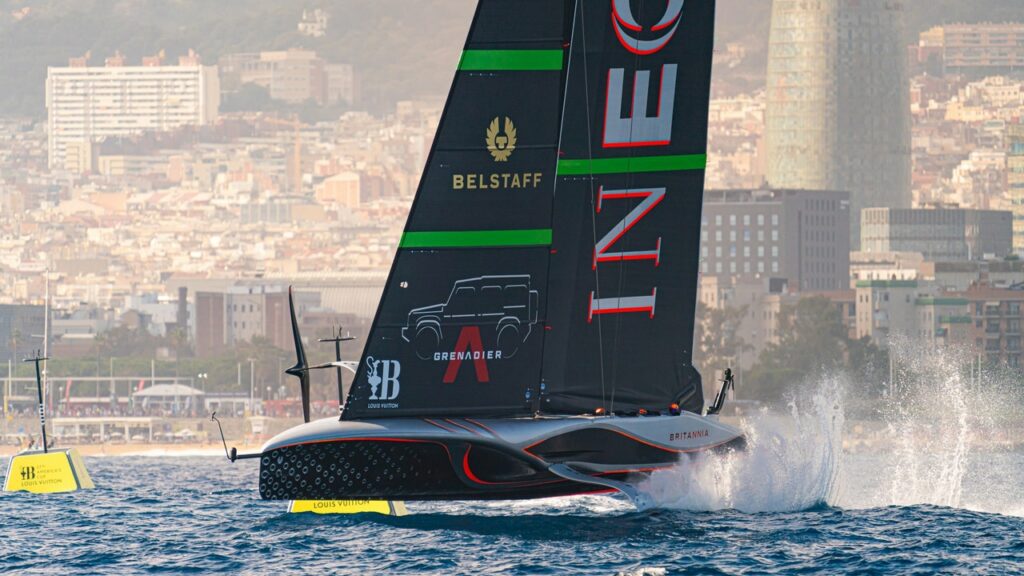“You do need some robustness and some sort of base fitness, but actually, physically, it’s not a hard role,” she says.
As well as gym time, much of Mills’ preparation revolves around visualisation, thinking what might happen so that if and when it does, she has a ready-made solution to hand. “I do a lot of prep on a race morning around set plays of the boat,” she says. “It’s kind of like chess, you can go through certain moves in your head and how you’re going to respond, how you’re going to communicate; what if this happens? What will I do? That’s been a big part of my routine. “
This sort of prep can make all the difference. An America’s Cup heat requires the two competing boats to complete there-and-back circuits between fixed buoys, inside a mapped out area. A minimum wind speed of six knots is required, and each heat will go for six to eight legs, depending on how much wind there is.
Watching this on TV, complete with handy graphics, it’s easy to visualise. Watching from the water, as GQ did for Wednesday’s second race, surrounded by a hundred spectator boats of all shapes and sizes, all at the mercy of the rather choppy currents, it’s a little harder to see what’s going on.
Ainslie, then, has to be on the top of his game, racing forwards while keeping an eye on a competitor, while considering wind speed, swells and much more. Tactics are vital. There is some rumbling within the GB camp that, at the start of leg three, NZ cut across INEOS Britannia’s path, forcing Ainslie’s team to swerve, incurring a penalty in the process.
The tactics gets dirtier. Pre-race we head out in a state of the art hydrogen chase boat for a thrilling dash through the waves. It’s more than just a joyride: on board is an INEOS Britannia team member equipped with a long-lens camera for “reconnaissance purposes”, in particular, shots of the Kiwi team’s sail choices.
“If we can recon that and relay it [to HQ] then we can tell them what the Kiwis are doing. It’s a giant, expensive game of chicken, waiting as long as humanly possible before you make your calls,” Thompson says, explaining that having boats out spying on one another is all part and parcel of the drama. “The history of spying in the cup goes back years and years.”
Post testing the conditions, each team has a small window to adjust their sail or jibs pre-race. After that, they’re stuck with what they’ve chosen and aren’t even allowed to receive weather data from the control room back in HQ.
In the America’s Cup, the reigning team sets the rules around boat size and type and then, like in Formula One, each team crafts their own boat to those specifications. Having been here for a few months to prepare for and race in the Louis Vuitton Cup – sort of the America’s Cup qualifiers which INEOS Britannia won at the start of October – there’s a feeling that the Brits are better prepared for a wider range of wind speed and chop, whereas the Emirates Team New Zealand have a more specific, less adaptable set-up. And while most of that is set in stone, elements can change last minute. Knowing this can give the other team the edge.
October 16, 2024. Louis Vuitton 37th America’s Cup, Race Day 3, Race 6. INEOS BRITANNIARicardo Pinto / America’s Cup
Source link : http://www.bing.com/news/apiclick.aspx?ref=FexRss&aid=&tid=6717c70e9453440887a6ea72d0cdf0a4&url=https%3A%2F%2Fwww.gq-magazine.co.uk%2Farticle%2Famericas-cup-ineos-britannias-experience-2024&c=9826292220116611041&mkt=en-us
Author :
Publish date : 2024-10-21 21:44:00
Copyright for syndicated content belongs to the linked Source.
